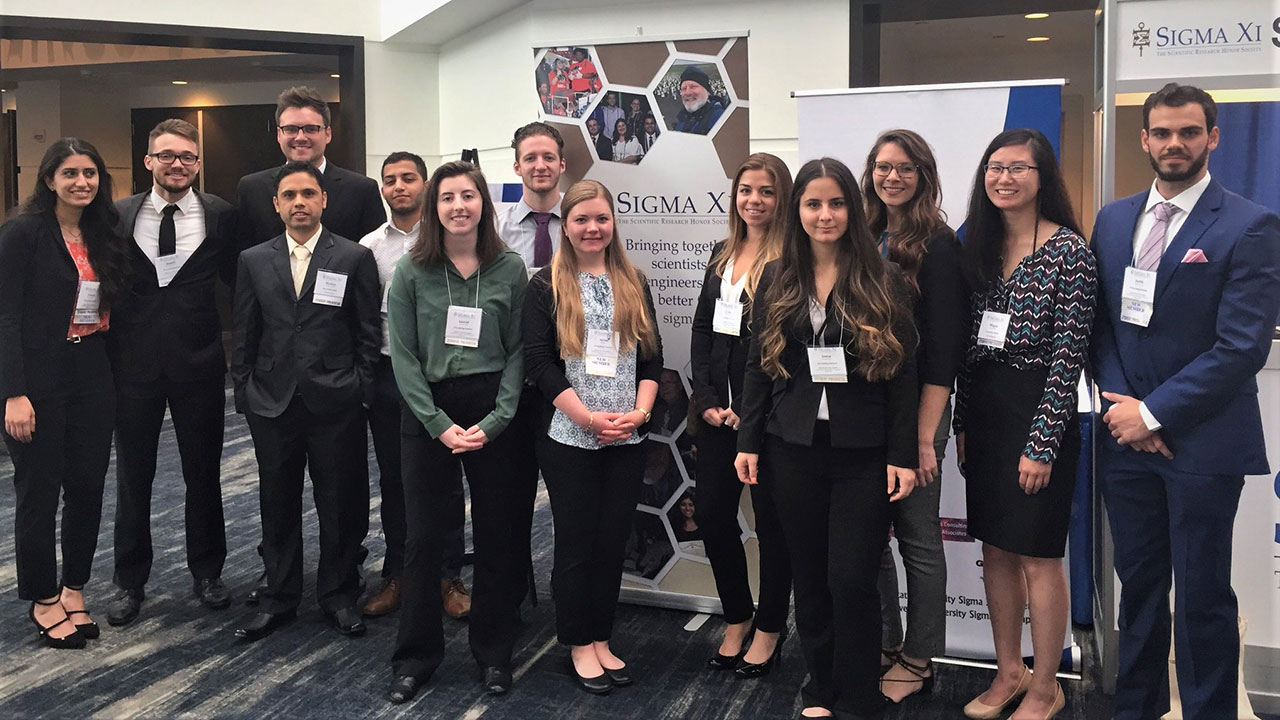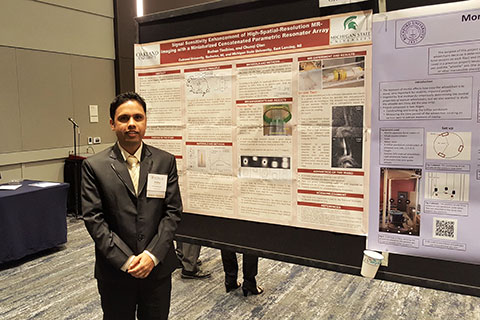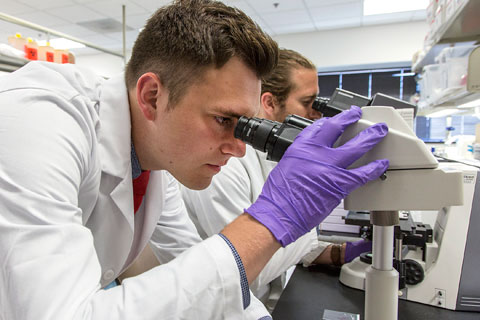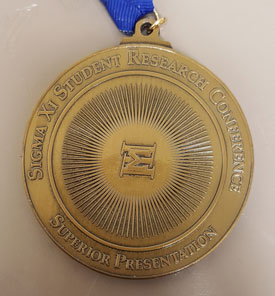Students attend Sigma Xi research conference; two take home awards
From left: Farrah Sitto, Daniel Czarnowski, Tyler Parsons (back), Roshan Timilsina (front), Peter Gaied (back), Laurel Levine (front), Dominic Mier (back), Annie Fuelle (front), Julia Crozier, Zeena Qiryaqoz (front), Julia Poirier, Megan Moore and Justin Kulchycki.

Two Oakland University graduate students, Roshan Timilsina and Tyler Parsons, received superior presentation awards at the 2018 Sigma Xi Annual Meeting and Student Research Conference, which took place October 25-28 in San Francisco, California.
Roshan Timilsina standing with his poster presentation at the Sigma Xi Student Research Conference. |
Timilsina, a Ph.D. student in Medical Physics, presented his research on "Signal Sensitivity Enhancement of High-Spatial-Resolution MR-Imaging with a Miniaturized Concatenated Parametric Resonator Array.”
His research seeks to develop advanced detection technologies for Magnetic Resonance Imaging and biosensors. Such advancements, he explained, could lead to “better and earlier identification of pathologies or tumors in the deep-lying tissues of the body, such as kidney, heart or even brain regions.”
Timilsina received a Superior Presentation Award in the Graduate division of Physics and Astronomy. His research adviser is Chunqi Qian, Ph.D., adjunct assistant professor in the Department of Physics at OU and assistant professor in the Department of Radiology at Michigan State University. His academic adviser is Brad Roth, Ph.D., professor of physics and director of the Ph.D. program in medical physics.
Tyler Parsons conducting research at the Beaumont Research Institute. |
Parsons’ presentation was titled “Tumor Microenvironment Effects on Hematopoietic Stem Cell Induced Tumor Growth Following Radiation Therapy."
His research builds upon work he has done in collaboration with OU and the Radiation Oncology Research group at the Beaumont Research Institute.
“We know that after radiation therapy a population of stem cells migrates from the bone marrow to the tumor, and we hypothesize that these stem cells are induced by the post-radiation tumor environment to differentiate into tumor-promoting cells,” he explained. “We are trying to understand the molecular mechanisms that are causing the stem cells to become tumor-promoting cells.”
Parsons, a Ph.D. student in Biomedical Sciences, received a Superior Presentation Award in the Graduate division of Cell Biology and Biochemistry. His adviser is Gerard Madlambayan, Ph.D., associate professor of biological sciences at OU.
Timilsina and Parsons each received a Superior Presentation Medal at the conference. |
Sigma Xi members, who are elected to membership because of their research accomplishments, evaluated each student's presentation. Students were judged based on the significance of their research, its goals and objectives, and having a clearly stated hypothesis. Judges also assessed each student's use of the scientific method and ability to answer questions.
The awards came with a medal, top presenter certificate, $150 honorarium and nominations to join Sigma Xi with a year of free membership. Sigma Xi is the international honor society for scientists and engineers. Its membership has included more than 200 Nobel laureates.
The event, titled “Big Data and the Future of Research,” also included career training sessions and talks from renowned scientists, including Jeff Dean, head of Artificial Intelligence at Google.
A total of 13 OU students presented their research at this year’s conference. They are from seven different labs in biology, chemistry, and the Eye Research Institute (ERI), and include both graduates and undergraduates. They work on a variety of topics that include the genetics of cardiovascular diseases, mechanisms triggering age-related nuclear cataract, and abnormalities in protein formation in cancers.
“Our Sigma Xi chapter is very focused on supporting student researchers and allowing them to present their work at a national conference,” said Fabia Battistuzzi, Ph.D., OU chapter president and associate professor of biological sciences. “These activities are pivotal in their growth as scientists and encourage them to develop and practice networking and communication skills that will be essential in their future careers.
According to Dr. Battistuzzi, OU’s Sigma Xi chapter has been very active since it was established more than 40 years ago. The chapter supports student research and organizes regular scientific seminars, including an annual banquet at Meadowbrook Hall with leading scientists in various fields of biology, chemistry, physics, and mathematics.
The original OU Sigma Xi Charter, dated March 19, 1975, is proudly displayed in the ERI in Dodge Hall. Two of the 39 founding members, Frank Giblin, Ph.D., distinguished professor of biomedical sciences and ERI director, and Mike Sevilla, Ph.D., distinguished professor in the Department of Chemistry, are still active research faculty and supporters of Sigma Xi.
The students’ participation at this year’s conference was also supported by Oakland University’s President, Provost, CAS Dean, Research Office, Eye Research Institute, Center for Biomedical Research, and Biological Sciences department.
Full list of student presentations:
Julia Crozier, “Isolation and Expansion of Human Cardiac Stem Cells using Biomarkers Isl-1 and Integrin a6.” Mentored by Luis Villa-Diaz, Ph.D., assistant professor, biological sciences
Daniel Czarnowski, “Hypoxia Modulates Expression of Integrins, Syndecans, and Laminins in Human Embryonic Stem Cells and MDA-MB-231 Inflammatory Breast Cancer Cells.” Mentored by Luis Villa-Diaz, Ph.D., assistant professor, biological sciences
Julia Poirier, “Detection of Bacterial Cell-surface Capacity for Lectin Binding Induced by Acquisition of Antibiotic Resistance using Biosensor Methods.” Mentored by Arik Dvir, Ph.D., associate professor of biological sciences
Ann Fuelle, “DNA Recognition by the BRCA1 Tumor Suppressor Protein.” Mentored by Colin Wu, Ph.D., assistant professor, biochemistry.
Dominic Mier, “Transfection of Cultured Human Lens Epithelial Cells with the Gene for aA 66-80 Peptide Results in Aggregation of aA-crystallin.” Mentored by Frank Giblin, Ph.D., distinguished professor, biomedical sciences.
Peter Gaied, “Use of recombinant DNA technology and electron microscopy to study the role of disulfide cross-linking in the formation of alpha A-crystallin amyloid fibrils in vitro.” Mentored by Frank Giblin, Ph.D., distinguished professor, biomedical sciences
Megan Moore, “Dose-Response Differences in VEGF-Regulated Gene Expression by Isoforms of VEGFA165 in Primary Human Retinal Endothelial Cells.” Mentored by Ken Mitton, Ph.D., associate professor, biomedical sciences
Zeena Qiryaqoz, “Integrin a6 as a Marker to Identify Mesenchymal Stem Cells.” Mentored by Luis Villa-Diaz, Ph.D., assistant professor, biological sciences
Roshan Timilsina, “Signal Sensitivity Enhancement for High-Spatial-Resolution MR Imaging from a Miniaturized Integrated RF-Resonator.” Mentored by Chunqi Qian, Ph.D., adjunct assistant professor, physics, Oakland University, and assistant professor, radiology, Michigan State University
Farrah, Sitto, “Large-Scale Pan-Genome Analysis of Bacterial Species.” Mentored by Fabia Battistuzzi, Ph.D., associate professor, biological sciences
Tyler Parsons, “Tumor Microenvironment Effects on Hematopoietic Stem Cell Induced Tumor Growth Following Radiation Therapy.” Mentored by Gerard Madlambayan, Ph.D., associate professor, biological sciences
Laurel Levine, “Novel Interaction of RGH3 with ARMC7 Provides Insight into Mechanism Required for the Proper Splicing of U12 Introns and Normal Development of Corn Kernals.” Mentored by Shailesh Lal, Ph.D., professor, biological sciences.
Justin Kulchycki, “A 5.8 Kilobase Chromosome 11 Genomic Locus is a Molecular Switch for Cell Type-Specific B4galnt2 Expression in Mice.” Mentored by Randal Westrick, Ph.D., assistant professor, biological sciences
To learn more about research at OU, visit oakland.edu/research.


 November 12, 2018
November 12, 2018

